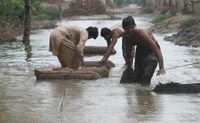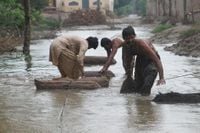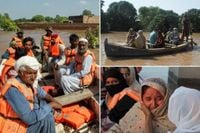Flood-ravaged Punjab province in Pakistan has been gripped by tragedy after a series of rescue boat accidents claimed at least 10 lives, including children, as authorities struggled to evacuate thousands from rising waters. The fatal incidents, which unfolded near Multan and Bahawalnagar between September 9 and 12, 2025, have underscored the immense challenges faced by emergency services amid one of the region’s worst flood disasters in recent memory.
According to the Associated Press, a rescue boat carrying 20 people capsized on the swollen Indus River on Tuesday, September 9, when strong winds and fast currents caused it to lose balance. Musarrat Jabeen, the top government administrator for the region, confirmed that the initial search recovered five bodies during hours of rescue operations. By early Thursday, four more were pulled from the water by teams including Pakistan Army divers, bringing the death toll from that incident to nine. The victims included women and children, highlighting the vulnerability of those most desperate for escape.
But this was not an isolated tragedy. As reported by Punjab Emergency Services Rescue 1122 and The Tribune, three rescue boats capsized near Multan and Bahawalnagar during evacuation operations, resulting in the deaths of at least 10 flood victims, including children, on Friday, September 12. Officials said that rescuers managed to save 40 people from the water after the boats overturned. The Punjab Information Minister, Azma Bokhari, stated at a press conference, "Since the start of floods in Punjab on August 23, 78 persons lost their lives, 4.2 million people have been impacted/displaced." With the latest casualties, the official death toll in the province has climbed to 88.
The scale of the disaster is staggering. Since late August, floods have submerged more than 4,500 villages in Punjab province, affecting over 4.4 million people and forcing at least 2.4 million evacuations, according to the Punjab Disaster Management Authority. The entire province, considered Pakistan’s breadbasket and home to half of the country’s 240 million residents, has seen large swaths of crops inundated, further threatening food security and livelihoods.
The causes of the flooding are multifaceted. Officials told Reuters and other agencies that heavier-than-normal monsoon rains, combined with repeated water releases from overflowing Indian dams, have swollen the Chenab, Sutej, and Indus rivers. The result has been relentless deluges that have overwhelmed embankments and forced tens of thousands from their homes. In Jalalpur Pirwala city, for example, the Chenab and Sutej rivers flooded the region after water was released from Indian dams, displacing entire communities. Relief Commissioner Nabil Javed said that nearly 142,000 people in Jalalpur Pirwala and dozens of nearby villages have been affected.
Authorities have scrambled to respond. Emergency services have deployed 100 boats equipped with life jackets and floodlights, as well as four helicopters, to facilitate evacuations and deliver food. Yet, the sheer magnitude of the crisis has exposed gaps in resources and coordination. Many displaced residents have moved in with relatives, while others are spending nights in relief camps or makeshift shelters along roads and embankments. Some say they are still waiting for help, with insufficient evacuation boats and private operators charging excessive fares.
Amid mounting frustration, senior government officials have sought to reassure the public and clamp down on profiteering. Punjab Chief Minister Maryam Nawaz Sharif visited Jalalpur Pirwala on Wednesday, September 10, and ordered police to take action against private boat owners demanding high fees from stranded families. "After my visit to Jalalpur, I have directed strict police monitoring of all boat operations," Sharif announced on social media. She also pledged that the government would compensate private boat owners for evacuations, emphasizing that the focus must remain on saving lives, not profiting from tragedy.
Senior Punjab Cabinet Minister Marriyum Aurangzeb echoed these sentiments, telling residents she was personally overseeing rescue and relief efforts after complaints about the shortage of evacuation boats and the high costs imposed by private operators. The government’s response has included reinforcing embankments to protect vulnerable areas like Jalalpur Pirwala, where deluges have begun inundating nearby villages.
Despite these efforts, rescue operations have been hampered by the reluctance of some villagers to leave their homes, particularly without their livestock—often their main source of income. The Punjab Disaster Management Authority noted that “the rescue work in the region is tough because people are not cooperating.” Forced evacuations have become a last resort in some areas, as villagers cling to their possessions in the face of rising waters. According to NDTV and The Straits Times, rescue officials have repeatedly encountered resistance from rural residents unwilling to abandon cows, goats, and other animals, complicating what are already perilous operations.
The cumulative toll from this year’s intense monsoon rains and swollen rivers is grim. Since late June, floods have killed 946 people across Pakistan, including 97 in Punjab province, according to official figures. The death toll in Punjab alone rose from 78 to 88 following the recent boat accidents, while more than 16,000 people have been rescued from affected areas in southern Punjab, as reported by Devdiscourse and PTI.
The devastation extends beyond immediate fatalities. With over 4.2 million people displaced or otherwise affected in Punjab, the humanitarian crisis is deepening. Many have lost their homes, livelihoods, and—tragically—their loved ones. Farmers have been seen moving produce through flooded streets, trying to salvage what they can amid the chaos. The risk of disease outbreaks, food shortages, and long-term displacement looms large as the waters show little sign of receding.
Yet, amid the heartbreak, stories of survival and resilience persist. Emergency workers, army divers, and volunteers have braved treacherous conditions to pull survivors from the water and deliver vital supplies. Punjab Emergency Services Rescue 1122 reported that, despite the capsizing of three boats, 40 people were rescued, a testament to the courage and dedication of those on the front lines.
As the province faces the daunting task of recovery, questions remain about disaster preparedness, resource allocation, and the need for cross-border cooperation to manage shared river systems. For now, the focus remains on saving lives and providing relief to millions whose worlds have been upended by the floodwaters. The people of Punjab, like so many before them, are left to pick up the pieces and hope that the worst has finally passed.






